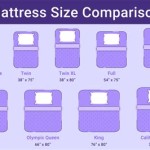What Size Rug For California King Bed: A Comprehensive Guide
Selecting the correct rug size for a California king bed is vital for achieving a balanced and aesthetically pleasing bedroom. The rug serves as an anchor, defining the space and adding warmth and texture. A rug that is too small can make the room feel disjointed, while one that is too large can overwhelm the space. This guide provides a comprehensive overview of recommended rug sizes and considerations to ensure a harmonious bedroom design.
A California king bed, distinguished by its longer length and narrower width compared to a standard king, requires careful consideration when choosing a rug. The dimensions of a California king bed are typically 72 inches wide by 84 inches long. These specific dimensions influence optimal rug placement and size selection.
Understanding Standard Rug Sizes and Placement
Several standard rug sizes are commonly used in conjunction with California king beds. These sizes each offer a distinct visual effect and cater to different room layouts and design preferences. The most frequently used sizes include 8x10, 9x12, and 10x14 feet.
The 8x10 rug is often considered the minimum size for effectively anchoring a California king bed. With this size, the rug is typically placed so that the front two-thirds of the bed rest on the rug, leaving a significant portion of the rug visible on both sides and at the foot of the bed. This configuration creates a defined space around the bed while allowing for comfortable footing when getting in and out of bed.
A 9x12 rug offers more substantial coverage and is a popular choice for many bedrooms. This size typically allows for the entire bed to rest on the rug, with a generous border of rug extending beyond the sides and foot of the bed. This creates a more luxurious and cohesive look, providing ample space for nightstands to sit comfortably on the rug as well. The increased rug area also provides more underfoot comfort and sound absorption.
The 10x14 rug provides the most expansive coverage and is best suited for larger bedrooms where a grander statement is desired. With this size, the entire bed and nightstands easily fit onto the rug, creating a unified and opulent feel. This configuration truly anchors the entire bedroom furniture arrangement, establishing a clear focal point and enhancing the overall sense of space and elegance.
Key Considerations for Rug Size Selection
Beyond standard sizes, several critical factors influence the selection of the appropriate rug size for a California king bed. These include the overall room dimensions, furniture placement, and desired aesthetic.
The room's dimensions are paramount. A rug that is too large for a small room can make the space feel cramped, while a rug that is too small in a large room can appear insignificant. Measure the room carefully and consider the placement of other furniture, such as dressers, chairs, and benches. Aim for a balanced proportion between the rug, the bed, and the surrounding space.
Furniture placement also plays a crucial role. As mentioned previously, consider whether you want the nightstands to sit entirely on the rug. If so, a larger rug is necessary. If the nightstands will be placed off the rug, an 8x10 rug may suffice. Also, consider the placement of other furniture pieces in the room. Ensure that the rug does not obstruct doorways or pathways, and that it complements the overall furniture arrangement.
The desired aesthetic is a subjective but important consideration. A larger rug generally conveys a more luxurious and grounded feel, while a smaller rug can create a more minimalist or contemporary look. Consider the overall style of the bedroom and choose a rug size that complements the existing décor. If the bedroom features bold patterns or colors, a larger rug can help to unify the design. If the bedroom is more understated, a smaller rug may be sufficient to add a touch of texture and warmth.
Alternative Rug Placement Options and Considerations
While the previously discussed options are common, alternative rug placement methods can create unique visual effects and address specific spatial constraints. These methods require careful planning and consideration to ensure a cohesive and balanced design.
One alternative is to place the rug perpendicular to the bed, extending primarily on the sides. This configuration works well in rooms with limited space at the foot of the bed. The rug is positioned to provide comfortable footing alongside the bed, while leaving the foot of the bed free. This can help to visually elongate the room and create a more open feel.
Another option is to use multiple smaller rugs instead of one large rug. This approach allows for greater flexibility in defining different zones within the bedroom. For example, a smaller rug can be placed at the foot of the bed to create a seating area or a separate rug can be placed under each nightstand. This method can be particularly effective in larger bedrooms where distinct functional zones are desired.
Layering rugs is another increasingly popular trend. This involves placing a smaller, decorative rug on top of a larger, neutral rug. This technique adds depth, texture, and visual interest to the room. The larger rug serves as a base, while the smaller rug acts as an accent piece. When layering, it's important to consider the colors, patterns, and textures of the rugs to ensure a harmonious and cohesive look. Consider the pile height of each rug, opting for a thinner rug on top to avoid tripping hazards.
Irrespective of the chosen placement method, it is crucial to ensure that the rug is properly secured to prevent slipping or bunching. A rug pad is highly recommended to provide cushioning, prevent the rug from moving, and protect the flooring underneath. Choose a rug pad that is slightly smaller than the rug to avoid visibility around the edges. Different types of rug pads are available, including those made from felt, rubber, and memory foam, each offering varying levels of cushioning and grip.
In addition to size and placement, the material and pile of the rug should also be considered. Natural fibers, such as wool and cotton, are durable and comfortable underfoot. Synthetic fibers, such as nylon and polyester, are more stain-resistant and easier to clean. The pile height of the rug affects its texture and maintenance requirements. High-pile rugs are plush and luxurious but can be more difficult to clean, while low-pile rugs are more practical and easier to maintain.
Lighting can also impact how a rug appears in the room. Natural light can enhance the colors and patterns of the rug, while artificial light can alter its tone. Consider how the rug will look under different lighting conditions to ensure that it complements the overall ambiance of the bedroom.
Ultimately, selecting the right rug size for a California king bed requires careful consideration of several factors, including room dimensions, furniture placement, desired aesthetic, and personal preferences. By understanding the standard rug sizes and placement options, as well as the key considerations discussed, it is possible to choose a rug that enhances the beauty and functionality of the bedroom and creates a comfortable and inviting space.

Incredible What Size Rug For California King Bed Ideas Bedroom Placement Area

What Size Rug For A King Bed Chart Layout Designs Homely Rugs Bedroom California Bedding Placement

What Size Is Suitable For The King Bed Rug Guide

What Size Rug For A King Bed Chart Layout Designs Homely Rugs Bedroom Placement Beds

Fantastic Rug Under King Bed Snapshots Luxury Or Related Post 11 Area U Bedroom Placement Queen Size For

How To Choose The Right Rug Size

Pin On Sypialnie Bedrooms

What Size Is Suitable For The King Bed Rug Guide

Image Result For Rug Size Eastern King Bedroom Placement Furniture Layout

Exciting Tips To Choose Area Rug Size For King Bed 2024 Gallery








